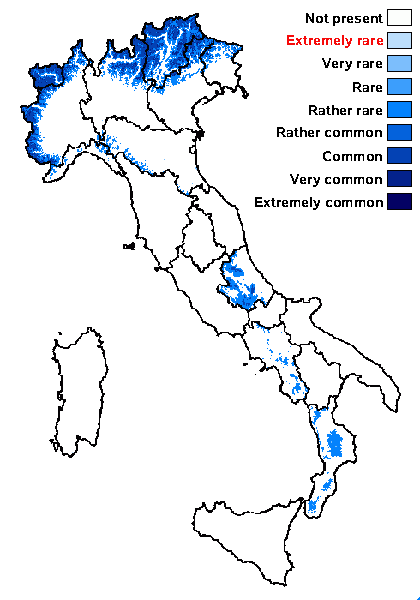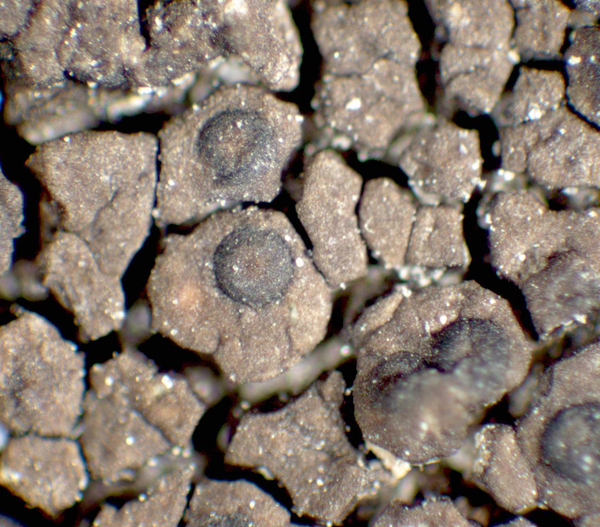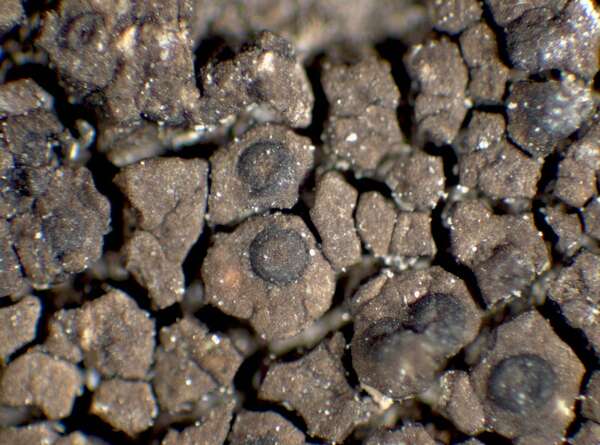Staurothele areolata (Ach.) Lettau
Hedwigia, 52: 84, 1912. Basionym: Pyrenula areolata Ach. - Syn. Meth. Lich.: 122, 1814.
Synonyms: Staurothele clopima auct. p.p. non (Wahlenb.) Th. Fr.
Distribution: N - Frl (Watson 2014), Ven (Nimis 1994, Nascimbene & Caniglia 2003c, Nascimbene 2005c, 2008, 2008c), TAA (Nascimbene 2003, 2008b, Nascimbene & al. 2005, 2006, 2022, Spitale & Nascimbene 2012), Lomb, Piem (Isocrono & al. 2004, Favero-Longo & al. 2015), VA (Piervittori & Isocrono 1999, Isocrono & al. 2008, Favero-Longo & Piervittori 2009, Blisa & al. 2011), Emil (Dalle Vedove & al. 2002, Fariselli & al. 2020), Lig (TSB 34499b). C - Abr (Nimis & Tretiach 1999). S - Camp, Cal (Puntillo 1996).
Description: Thallus crustose, episubstratic, dark brown to brown-black in sun-forms, areolate, secondarily cracked into small groups of areoles. Areoles at first flat, then strongly convex, the fertile ones larger, often constricted at base. Perithecia black, 1(-2) per areole, 0.2-0.3 mm across, completely immersed and poorly visible, or slightly projecting, the apex appearing as a black dot. Involucrellum present, confined to the apex of exciple; hymenium I+ blue; hymenial algae oblong to narrowly oblong, 2-4 times as long as wide, 5-12(-18) x 2-4(-5) μm; paraphyses absent; periphyses and periphysoids present. Asci 2-spored, clavate, the wall thickened above, with an ocular chamber, after dehiscence with a delicate extruded endotunica, I-, K/I-. Ascospores muriform, brown, oblong-ellipsoid, often of different sizes in the ascus, the upper one 40-52 x 21-25 μm, the other to 30 μm long and 12-14 μm wide. Photobiont chlorococcoid, present in both thallus and hymenium. Spot tests: K-, C-, KC-, P-, UV-. Chemistry: without lichen substances.Note: an arctic-alpine to boreal-montane, circumpolar species found on calcareous to basic siliceous rocks wetted by rain in open habitats (e.g. on boulders in alpine and subalpine grasslands); very common throughout the Alps. According to Wirth (1995) this is a possible synonym of S. frustulenta, but specimens from upland areas clearly differ from those collected at lower altitudes (treated here as S. frustulenta).
Growth form: Crustose
Substrata: rocks
Photobiont: green algae other than Trentepohlia
Reproductive strategy: mainly sexual
Commonnes-rarity: (info)
Alpine belt: common
Subalpine belt: very common
Oromediterranean belt: very rare
Montane belt: rather rare
Submediterranean belt: absent
Padanian area: absent
Humid submediterranean belt: absent
Humid mediterranean belt: absent
Dry mediterranean belt: absent

Predictive model
Herbarium samples
Growth form: Crustose
Substrata: rocks
Photobiont: green algae other than Trentepohlia
Reproductive strategy: mainly sexual
Commonnes-rarity: (info)
Alpine belt: common
Subalpine belt: very common
Oromediterranean belt: very rare
Montane belt: rather rare
Submediterranean belt: absent
Padanian area: absent
Humid submediterranean belt: absent
Humid mediterranean belt: absent
Dry mediterranean belt: absent

Predictive model
| Herbarium samples |
 Index Fungorum
Index Fungorum
 GBIF
GBIF




